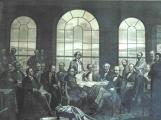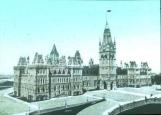14
While the commercial and political union of British North America called for greater autonomy from Britain and a greater say in local affairs by local people, there was never a question of outright independence from the Crown. Loyalty to the monarchy ran far too deeply to be dismissed as casually as some thought had happened in the Unites States almost a century early. The challenge for the politicians was to achieve some kind of middle ground between the republican optimism of America and the imperialist sentiment of Britain.15
Photograph: Queen Victoriac. 1880
London, England
 Credits:
Credits:Queens County Historical Society & Museum Inc.
16
At Charlottetown and then later that year in Quebec, Tilley, Macdonald and others moved swiftly toward an agreement on Confederation. The road was not totally smooth, of course. After the Quebec Conference, Tilley returned to New Brunswick to face considerable opposition to union. Rather than force the issue through the legislature in 1864, Tilley stood on principle and decided the people should have their say on such a serious question. With a mandate set to expire in the summer of 1865, Tilley made the Confederation question an election issue; a vote for him meant union, a vote against meant the status quo. To his great disappointment he and Confederation were defeated.But as with Tilley's earlier setbacks, this one too was only temporary. The Anti-Confederation government fell within a year and Samuel Leonard Tilley once again found himself in a position to make history. Not as premier this time, but his stature within the affairs of the province and his party gave him plenty of influence.
17
Photograph: Samuel Leonard Tilleyc. 1865
Saint John, New Brunswick, Canada
 Credits:
Credits:New Brunswick Museum
18
As Confederation became a reality in New Brunswick in 1866, Canadian artist Robert Harris captured the historical events of the past two years on a grand canvas. Already the provincial representatives were being referred to as Fathers of Confederation. The subsequent painting was an amalgamation of the scenes at the Charlottetown and Quebec Conferences. John A. Macdonald is the center subject of the painting, however just to the left of center, sits a distinguished gentleman with a book on his lap, Samuel Leonard Tilley.In late 1866 representatives headed to London for the final negotiations with Britain. Within a month the final package was ready for passage by the British Parliament. Perhaps Tilley's most lasting imprint on the nation he helped create was the official name of the country, the Dominion of Canada. An often told story and one that is entirely believable, is that during his daily Bible reading, Tilley was impressed by Psalm 72:8, "He shall have dominion also from sea to sea, and from the river unto the ends of the earth." His suggestion was well received and the Dominion of Canada we became.
19
Print: Father of Confederation by Robert Harrisc. 1900
Ottawa, Ontario, Canada
 Credits:
Credits:Gift of Frederick M. and Paulina Crocker, 1972
Queens County Historical Society & Museum Inc.
20
The British North America Act 1867 came into effect 1 July 1867, thereafter celebrated as Dominion Day and Canada Day. Whether it was the completion of an exhaustive process to which he had dedicated his entire being or the desire to share his success and remaining life with a partner, Samuel Leonard Tilley married Alice Chipman, the daughter of a close friend, 22 October 1867. A generation younger than her husband, the new Mrs. Tilley promised a fresh outlook and would soon prove an asset to the next stage in her husband's career.This watercolour portrait of Alice Chipman Tilley was painted in 1868 by William Notman, Montreal. Using a modern technique, the portrait is actually an overpainted photograph produced in the Notman Studio.
21
Painting: Alice Chipman Tilley1868
Saint John, New Brunswick, Canada
 Credits:
Credits:Gift of Alice Tilley MacKeen, 1975
Queens County Historical Society & Museum Inc.
22
With children from his first marriage still at home, Samuel Leonard Tilley started a second family with his second wife. Herbert Chipman Tilley was born in 1868, followed by a second son, Leonard Percy DeWolfe Tilley in 1870.23
Photograph: Alice Tilley and Herbert Chipman Tilleyc. 1869
Ottawa, Ontario, Canada
 Credits:
Credits:New Brunswick Museum
24
As a reward for his support for Confederation, Samuel Leonard Tilley was given the post of Minister of Customs and Excise in John A. Macdonald's first Federal Cabinet. Hopes had been that the Department of Finance would be offered, however it was clear early on that Macdonald would not entrust that portfolio to anyone other than a trusted Upper Canadian. Although an inferior cabinent post, Tilley accepted and soon took up residence in Ottawa as the one of the elected representatives from Saint John.25
Lantern slide: Parliament Buildings1900-1920
Ottawa, Ontario, Canada
 Credits:
Credits:New Brunswick Museum
26
For his travels between New Brunswick and Ottawa, Samuel Leonard Tilley used this large oak travelling trunk. A paper tag from the 1870s remains attached to the piece reading "Mr. Honourable S.L. Tilley, CB / Ottawa".27
Travelling chest belonging to Samuel Leonard Tilleyc. 1870
Ottawa, Ontario, Canada
 Credits:
Credits:Collection of Peter Moreira
Queens County Historical Society & Museum Inc.